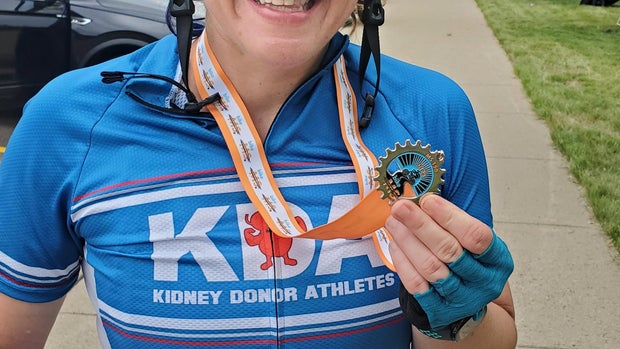Minnesota State Trooper Kristie Sue Hathaway earned a commendation in 2012 for saving a life on the job, but it’s not the only lifesaving move she has made.
In 2021, Hathaway stepped forward to donate a kidney. In May, she made a second donation, this time giving away a piece of her liver.
Both donations were non-directed, meaning the organs went to total strangers. Hathaway told CBS News that she learned about the process of non-directed live organ donation when a friend fell ill. She wanted to donate an organ then, but was the wrong blood type. Still, the situation stirred something in her, and she decided to “look into what goes into donating a kidney.”
“Once I did some digging, I learned that … you don’t need to know the person. And I was like, ‘I’ll do that. I’m healthy, and if I ever came across someone that needed one, I’d give them a kidney, so why not?'” Hathaway, 40, told CBS News. “I just felt like I needed to do it.”
Steve Hilyar
What is live organ donation?
Live organ donations account for thousands of organ transplants each year, according to the United Network for Organ Sharing, the nonprofit that manages the United States’ organ transplant system, though most donations come from deceased people.
The kidney is the most commonly transplanted organ from a living donor, followed by the liver, according to the network’s website. Most other organs can’t be transplanted from live donors because of their role in the human body, said Mayo Clinic transplant surgeon Dr. Timucin Tanner, who was involved in Hathaway’s donations.
In “rare cases, a uterus or segments of other organs” may be transplanted, according to the network.
Potential donors are screened for mental and physical health, and for compatibility with the recipient of an organ. In kidney donations, one of a person’s two kidneys is transplanted from the living donor to the recipient. In a liver transplant, a section of the liver is transplanted from the recipient into the donor. In the donor, another part of the organ regenerates to compensate for the loss, and in the recipient, the transplanted piece grows to nearly full-size.
More than 101,000 people in the United States are awaiting a kidney donation, the National Kidney Foundation says online, but just about 17,000 receive one each year. About 12 people die a day waiting for a transplant, according to the foundation. When it comes to the liver, about 14,000 people nationwide are waiting for a liver transplant, according to the American Liver Foundation.
Steve Hilyar
People can spend years on waiting lists.
“There are a lot of people at any given time who don’t have access to livers or kidneys,” said Tanner said. “We just don’t have enough deceased donor organs in this country, so living donation is a great thing.”
Tanner said that beyond the initial operation and recovery period, living donors do not experience “long-term consequences” from giving away an organ. The Zweig Family Center for Living Donation at Mount Sinai Hospital recommends that a living liver donor not drink alcohol for the first six months after donation, and advises against becoming pregnant until at least a year later. Living donors receive follow-up check-ups annually for five years, according to the center. The National Kidney Foundation recommends a living kidney donor wait at least a year to become pregnant.
Six months after her liver donation, Hathaway said she is already back to her normal routine of running about 20 miles a week, and recently returned to work at her post of more than 12 years. Tanner said he has seen patients run marathons shortly after recovering from a donation.
Steve Hilyar
“There are some misconceptions about living donation,” said Tanner. “People sometimes think they’re not able to be active or have a normal life afterwards. Those are all misconceptions. None of those are true.”
Tanner said that Hathaway cannot make any more live organ donations, but the state trooper told CBS News that she is still working to make a difference and help those around her. She’s registered as a bone marrow donor, and she regularly donates blood. She’s also trying to educate others about live organ donation.
Celebrating the “ripple effect”
Hathaway said that both times she donated, she has signed a release allowing the recipient to contact her. She has not heard from the person who received a piece of her liver, but the recipient of her kidney, a 29-year-old veteran, sent a “very small note,” followed by a longer letter from his mother.
Steve Hilyar
Part of what spurred Hathaway’s decision to be a live organ donor is what she calls the “ripple effect” that occurs when someone receives a necessary, often life-saving organ transplant. In the case of the man who received her kidney, he had run out of dialysis access points and would no longer be able to treat a chronic condition without a new organ. Since the donation, he has returned to work and no longer needs dialysis, Hathaway said.
“You actually have made a measurable difference, and not just for the person getting it. It’s their whole family,” said Hathaway. “They might have kids. They might have grandkids. You can’t really put a price on somebody getting a few extra Christmases or a few extra birthdays or getting to attend a wedding that they wouldn’t have otherwise been able to attend.”




